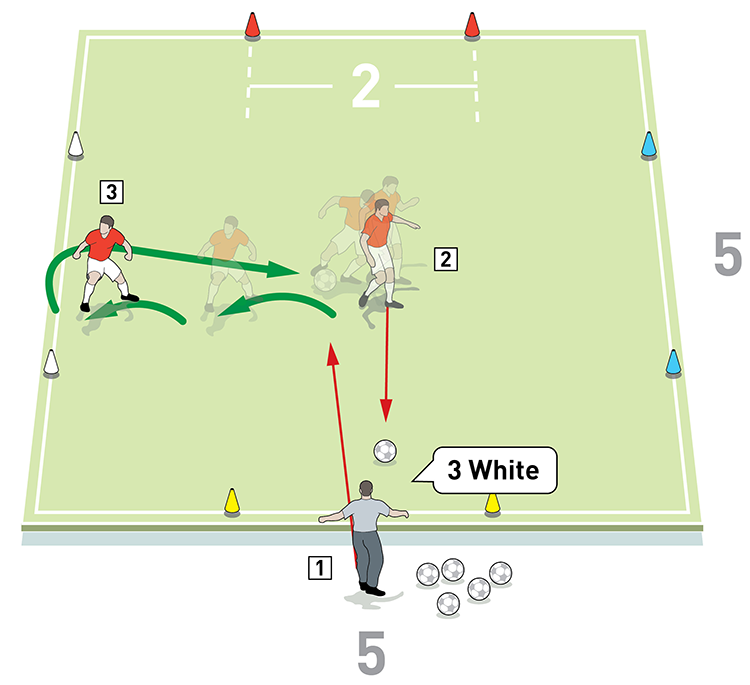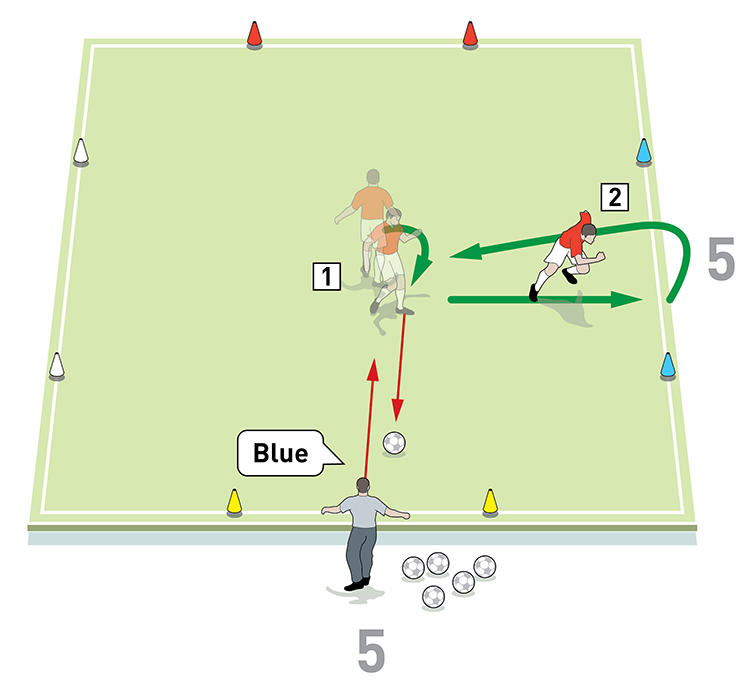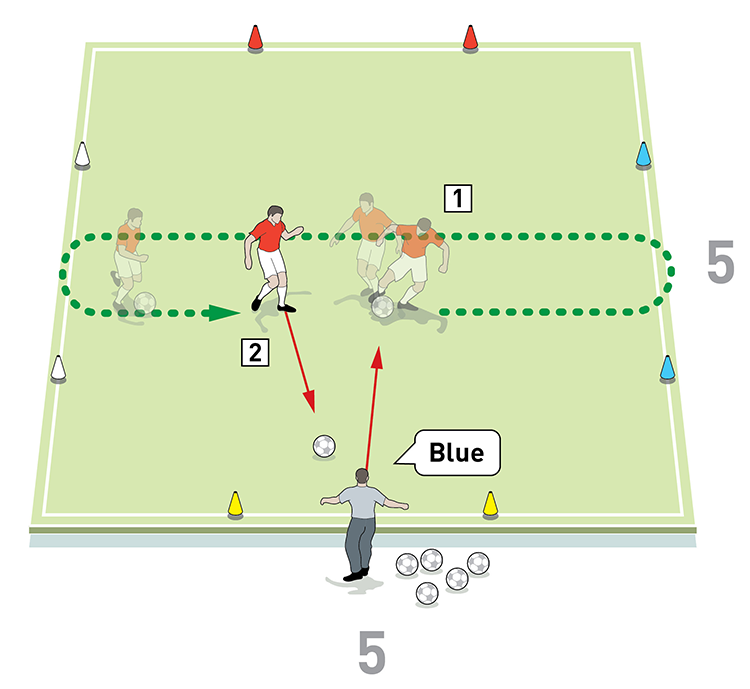One-to-one fitness session
The session is designed to be delivered by a coach on a one-to-one basis and all exercises are based on the movement patterns and physiological demands of the game. All drills are sport-specific and can be adapted to be position-specific based on a player’s individual requirements.

| Area | Up to 50x20 yards |
| Equipment | Balls, cones, poles,1 mannequin |
| No. of Players | 1 player |
| Session Time | Total session: 75-90mins |
The session is designed to be delivered by a coach on a one-to-one basis and all exercises are based on the movement patterns and physiological demands of the game. All drills are sport-specific and can be adapted to be position-specific based on a player’s individual requirements.
The exercises and drills are designed to maintain and improve fitness levels on a one-to-one basis and prevent detraining during a period of reduced match play. All energy systems have been integrated into a fun and challenging session, which is both geared towards injury prevention and sport enhancement. The number of repetitions and timings can be adapted by the coach to either increase or reduce the intensity. Minimal equipment and space are needed, which means the exercises can be delivered at a player’s home or where space is limited.
The whole session is designed to last 75-90 minutes and I recommend completing it with slight variations two or three times per week to prevent detraining and to maintain reaction times and maximum multi-directional speed and strength. If all drills are performed to the players max, then the Rate of Perceived Exertion (RPE) is 5/5 and players would need 24-36 hours recovery time between sessions.
What do I get the players to do?
Functional strength
This is a one-to-one activity using just one player. We set up a 5x5-yard box with a 2-yard cone gate on each side. Each gate is marked with different coloured cones and has a different exercise assigned to it by the coach. Depending on the coach’s instruction, the player takes takes between one and three touches and then moves to the relevant gate to complete the exercise…
Blue: sidestep to gate, lunging to the left
Yellow: forward lunge to gate
White: sidestep to gate, lunging to the right
Red: two-step backwards shuffle to gate
The coach calls the number of touches required and the colour of the cone gate. For instance, if the coach calls “3 white”, the player must receive the ball from the coach and take three touches to pass the ball back. He must then sidestep to the white gate and side-lunge before sidestepping back to the centre of the box, as shown [1a]. We run this practice for three blocks of one minute, with 30 seconds recovery between each block with the player in a plank variation.
1a

2. The player receives the ball from the coach and takes the required number of touches before passing back
3. The player then side-steps to the required gate and side-lunges, before side-stepping back to the centre ready to respond to the coach’s next call
Short shuttle runs
Using the same basic set-up as before, the player now faces away and turns around on the coach’s colour shout. The player receives a ball from the coach and bounces it back with one touch before sprinting to break the relevant coloured gate and returning to the centre, as shown [1b]. We run this exercise for one minute. We can progress this by requiring the player to shuttle to the relevant coloured gate and then to the opposite gate and back.
1b

2. The player then sprints to break the relevant coloured gate and returns to the centre ready for the coach’s next call
Ball dribble
Using the same basic set-up as before, this time the player starts in a lunge position. On the coach’s colour-command the player receives the ball, dribbles at speed to break the relevant gate and then turns to dribble to the opposite gate, before returning to the centre and passing back to the coach, as shown [1c]. We run this exercise for two blocks of one minute with 30 seconds to recover in between.
1c

2. The player turns to dribble to the opposite gate, before returning to the centre and passing back to the coach
On all three of these practices, the player should perform at maximum intensity. The coach can alter his passing distance and the weight of pass to challenge the player.
What do I get the players to do next?
Functional agility
We set up a playing area of approximately 32x20 yards with two 4x4-yard boxes marked as shown. There is also a 10x10-yard box marked, plus a mannequin and a 2-yard pole gate, positioned as shown [2].
2

2. He sprints to the mannequin and then backs up to centre of box B. He side-steps to his right and on his return to the centre of the box, he receives pass 2 from the coach and plays a right-footed bounce pass back
3. Side stepping the mannequin and sprinting through the pole gate, he turns to run diagonally through the large box. He receives pass 3 from the coach, returns it and then presses the ball
4. The coach plays pass 4 into the channel for the player to turn and sprint after. When he gains control at position E, the player turns and clips a long but catchable pass to the coach who has retreated to the finish at position F
5. If the coach catches the ball, the player sprints to the finish to complete the course. If not, the player has to make a forfeit run
The player starts in the first 4x4-yard box (box A) and drops to receive a pass from the coach to start the drill. The player then dribbles through the box, passes back to the coach and sprints towards the mannequin, decelerating just before arriving. The player then backs up to the centre of the second 4x4-yard box (box B) and side-steps to make a lateral lunge to his right and back. On his return to the centre of the box, he plays a bounce pass back to the coach with his right foot.
The player then continues his forward run, side-stepping the mannequin and sprinting through the pole gate before dropping his right shoulder and turning to run diagonally through the large box (box D). To encourage quick feet, the coach punches a pass as soon as the player turns and the player bounces the ball back first time and then presses the ball.
The coach then plays a channel pass for the player to turn and sprint after. When he gains control of the ball at position E, the player should turn and clip a long pass to coach who has retreated to the finish at position F. If the clipped pass is accurate and the coach can catch it with little trouble, then the player runs to the finish and rests. But if the pass is not on target, then the player has to make a forfeit run to box B before sprinting the finish.
We would run five repetitions of this on the left side and five repetitions on the right side.
Speed endurance ‘TT’ runs
The ‘T’ test is something that is used widely within sport as a test of agility. I have adapted the test and simply mirrored it to provide double the distance and to introduce an element of fatigue to measure both aerobic capacity and movement efficiency.
We set up in an area of 20x10 yards with three poles 5 yards apart at both the top and bottom ends of the area and with a row of three cones placed in the centre of the area. The player begins at the start/finish cone and sprints to pole A, as shown [3]. He then runs around pole B before making the 10-yard sprint to pole C and back to pole A. He then sprints 20 yards to the opposite pole A and runs around pole B and then C before sprinting back to the start/finish cone.
3

2. He then runs around pole B before making the 10-yard sprint to pole C
3. He runs around pole C and back to pole A at the top before turning to sprint down to the central cones again
4. He passes the central cones and runs to pole A at the bottom and repeats the same movement at the bottom of the area
5. After finishing the ‘T’ loop around the poles at the bottom, he sprints back to the start/finish cone in the centre
Each run is an 80-yard multi-directional maximum velocity sprint. Six runs are recommended to achieve a total distance of 480 yards. We would time each run and allow a short recovery period between each. We would usually suggest a 1:2 work-to-rest ratio but if you want to develop fatigue resistance of the hamstrings, then a 1:1 work-to-rest ratio can be attempted but this can affect the remainder of the session due to fatigue.
Long shuttle runs
We set up a course of 50 yards in length with a 2-yard cone gate at each end. A pole is placed in the centre of each end gate. Further cone gates are placed at the 10-yard, 25-yard and 40-yard points on the course. The first 10 yards constitute the acceleration/deceleration zone and the last 10 yards is the drive phase. The central cone gate indicates the halfway point of the course, as shown [4]. On the coach’s command, the player runs the length of the course, coming around the pole at the end and returning to the start. The player must complete six 50-yard lengths in each block of runs, totalling 300 yards. In each block, the runs are performed as follows…
4

2. Run 2 is diagonal sling shots, with the player kicking off each cone and running two lengths
3. Run 3 is diagonal sling shots again, but this time with a one-second stop-start at each cone. The player must run two lengths
4. Each block of three runs totals 300 yards. The player must repeat each block six times to run 1800 yards
Run 1: straight forward linear run with the player using the first 10-yard gate to hit coasting speed for the middle 30 yards. Two lengths.
Run 2: the player runs diagonal sling shots, kicking off each cone. Two lengths.
Run 3: the player runs diagonal sling shots again, but this time with a stop-start at each cone with a one-second pause before leaning in to restart the next section. Two lengths.
Each block of six lengths should be completed six times, so the total distance would be 1800 yards.
Time the player and aim for each block to be completed in 60 seconds, with a 1:2 work-to-rest ratio. This activity can be a good indication of fitness levels if the times start to drop from block to block.
What are the key things to look for?
Encourage players to perform all movements at maximum pace and emphasise the importance of staying in a reactive state at all times. A reactive state is an optimal body position that prompts players to stay in a triple flexed position (hip/knee/ankle) with nose over the toes/loading foot, regardless of direction of movement.
Working on a one-to-one basis is ideal for teaching players about how their body position can help them to control and generate force through the use of kinetic energy, which reduces injury risk and develops a more resilient and explosive athlete.
What are the typical mistakes players might make and how do I avoid them?
To get a motivated athlete and for a better buy in, explain the drills to the player before the session and describe the rationale for each exercise. I would encourage them not to pivot on a fixed foot and concentrate on optimising body position to maximise movement efficiency and minimise energy loss. Video analysis is excellent to play back to an athlete and provide tips on correct biomechanics and to give constructive feedback.
How would I put this in a game situation?
All drills and exercises are designed to mimic the movement patterns of the modern game. Distances and times are based on the physiological demands of a Premier league match using GPS data.
How long does the session last?
The session lasts approximately 75-90 minutes depending on rest times and the number of repetitions chosen by the coach.
I would tend to mix up the drills to keep the player motivated. I would also have the session set up prior to the player arriving, allowing for a more professional approach and a better chance of player buy in.
Editor's Picks
Attacking transitions
Deep runs in the final third
Using the goalkeeper in build-up play
Intensive boxes drill with goals
Penetrating the final third
Creating and finishing
My philosophy
Pressing initiation
Compact team movement
Coaches' Testimonials

Alan Pardew

Arsène Wenger

Brendan Rodgers

Carlos Carvalhal

José Mourinho

Jürgen Klopp

Pep Guardiola

Roy Hodgson

Sir Alex Ferguson

Steven Gerrard
Coaches' Testimonials

Gerald Kearney, Downtown Las Vegas Soccer Club

Paul Butler, Florida, USA

Rick Shields, Springboro, USA

Tony Green, Pierrefonds Titans, Quebec, Canada
Join the world's leading coaches and managers and discover for yourself one of the best kept secrets in coaching. No other training tool on the planet is written or read by the calibre of names you’ll find in Elite Soccer.
In a recent survey 92% of subscribers said Elite Soccer makes them more confident, 89% said it makes them a more effective coach and 91% said it makes them more inspired.
Get Monthly Inspiration
All the latest techniques and approaches
Since 2010 Elite Soccer has given subscribers exclusive insight into the training ground practices of the world’s best coaches. Published in partnership with the League Managers Association we have unparalleled access to the leading lights in the English leagues, as well as a host of international managers.
Elite Soccer exclusively features sessions written by the coaches themselves. There are no observed sessions and no sessions “in the style of”, just first-hand advice delivered direct to you from the coach.









